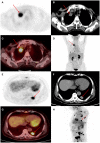Correlations Study Between 18F-FDG PET/CT Metabolic Parameters Predicting Epidermal Growth Factor Receptor Mutation Status and Prognosis in Lung Adenocarcinoma
- PMID: 31380265
- PMCID: PMC6657738
- DOI: 10.3389/fonc.2019.00589
Correlations Study Between 18F-FDG PET/CT Metabolic Parameters Predicting Epidermal Growth Factor Receptor Mutation Status and Prognosis in Lung Adenocarcinoma
Abstract
Purpose: This study assessed the ability of metabolic parameters from 18Fluorodeoxyglucose positron emission tomography/computed tomography (18F-FDG PET/CT) and clinicopathological data to predict epidermal growth factor receptor (EGFR) expression/mutation status in patients with lung adenocarcinoma and to develop a prognostic model based on differences in EGFR expression status, to enable individualized targeted molecular therapy. Patients and Methods: Metabolic parameters and clinicopathological data from 200 patients diagnosed with lung adenocarcinoma between July 2009 and November 2016, who underwent 18F-FDG PET/CT and EGFR mutation testing, were retrospectively evaluated. Multivariate logistic regression was applied to significant variables to establish a prediction model for EGFR mutation status. Overall survival for both mutant and wild-type EGFR was analyzed to establish a multifactor Cox regression model. Results: Of the 200 patients, 115 (58%) exhibited EGFR mutations and 85 (42%) were wild-type. Among selected metabolic parameters, metabolic tumor volume (MTV) demonstrated a significant difference between wild-type and mutant EGFR mutation status, with an area under the receiver operating characteristic curve (AUC) of 0.60, which increased to 0.70 after clinical data (smoking status) were combined. Survival analysis of wild-type and mutant EGFR yielded mean survival times of 34.451 (95% CI 28.654-40.249) and 53.714 (95% CI 44.331-63.098) months, respectively. Multivariate Cox regression revealed that mutation type, tumor stage, and thyroid transcription factor-1 (TTF-1) expression status were the main factors influencing patient prognosis. The hazard ratio for mutant EGFR was 0.511 (95% CI 0.303-0.862) times that of wild-type, and the risk of death was lower for mutant EGFR than for wild-type. The risk of death was lower in TTF-1-positive than in TTF-1-negative patients. Conclusion: 18F-FDG PET/CT metabolic parameters combined with clinicopathological data demonstrated moderate diagnostic efficacy in predicting EGFR mutation status and were associated with prognosis in mutant and wild-type EGFR non-small-cell lung cancer (NSCLC), thus providing a reference for individualized targeted molecular therapy.
Keywords: EGFR; PET/CT; lung adenocarcinoma; metabolic parameters; prognosis.
Figures



Similar articles
-
Predictive value of intratumor metabolic and heterogeneity parameters on [18F]FDG PET/CT for EGFR mutations in patients with lung adenocarcinoma.Jpn J Radiol. 2023 Feb;41(2):209-218. doi: 10.1007/s11604-022-01347-1. Epub 2022 Oct 11. Jpn J Radiol. 2023. PMID: 36219311
-
18F-fluorodeoxyglucose positron emission tomography/computed tomography-based radiomic features for prediction of epidermal growth factor receptor mutation status and prognosis in patients with lung adenocarcinoma.Transl Lung Cancer Res. 2020 Jun;9(3):563-574. doi: 10.21037/tlcr-19-592. Transl Lung Cancer Res. 2020. PMID: 32676320 Free PMC article.
-
Relation of EGFR Mutation Status to Metabolic Activity in Localized Lung Adenocarcinoma and Its Influence on the Use of FDG PET/CT Parameters in Prognosis.AJR Am J Roentgenol. 2018 Jun;210(6):1346-1351. doi: 10.2214/AJR.17.18916. Epub 2018 Mar 16. AJR Am J Roentgenol. 2018. PMID: 29547059
-
A Review of the Correlation Between Epidermal Growth Factor Receptor Mutation Status and 18F-FDG Metabolic Activity in Non-Small Cell Lung Cancer.Front Oncol. 2022 Apr 20;12:780186. doi: 10.3389/fonc.2022.780186. eCollection 2022. Front Oncol. 2022. PMID: 35515138 Free PMC article. Review.
-
FDG-PET/CT response evaluation during EGFR-TKI treatment in patients with NSCLC.World J Radiol. 2014 Jul 28;6(7):392-8. doi: 10.4329/wjr.v6.i7.392. World J Radiol. 2014. PMID: 25071879 Free PMC article. Review.
Cited by
-
Combination of 18F-Fluorodeoxyglucose PET/CT Radiomics and Clinical Features for Predicting Epidermal Growth Factor Receptor Mutations in Lung Adenocarcinoma.Korean J Radiol. 2022 Sep;23(9):921-930. doi: 10.3348/kjr.2022.0295. Korean J Radiol. 2022. PMID: 36047542 Free PMC article.
-
Diagnostic and Predictive Values of 18F-FDG PET/CT Metabolic Parameters in EGFR-Mutated Advanced Lung Adenocarcinoma.Cancer Manag Res. 2020 Jul 28;12:6453-6465. doi: 10.2147/CMAR.S259055. eCollection 2020. Cancer Manag Res. 2020. PMID: 32801885 Free PMC article.
-
Recent and current advances in PET/CT imaging in the field of predicting epidermal growth factor receptor mutations in non-small cell lung cancer.Front Oncol. 2022 Oct 6;12:879341. doi: 10.3389/fonc.2022.879341. eCollection 2022. Front Oncol. 2022. PMID: 36276079 Free PMC article. Review.
-
Can 18F-FDG PET/CT predict EGFR status in patients with non-small cell lung cancer? A systematic review and meta-analysis.BMJ Open. 2021 Jun 8;11(6):e044313. doi: 10.1136/bmjopen-2020-044313. BMJ Open. 2021. PMID: 34103313 Free PMC article.
-
Value of combining PET/CT and clinicopathological features in predicting EGFR mutation in Lung Adenocarcinoma with Bone Metastasis.J Cancer. 2020 Jul 11;11(18):5511-5517. doi: 10.7150/jca.46414. eCollection 2020. J Cancer. 2020. PMID: 32742498 Free PMC article.
References
LinkOut - more resources
Full Text Sources
Research Materials
Miscellaneous

